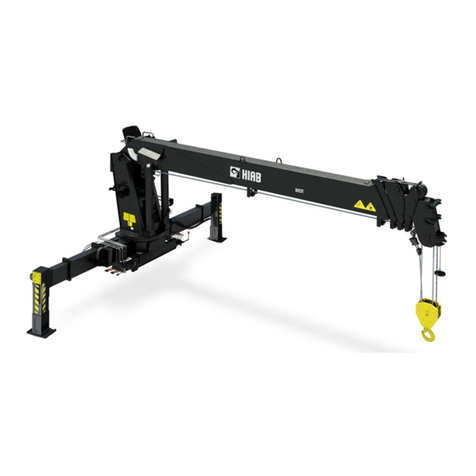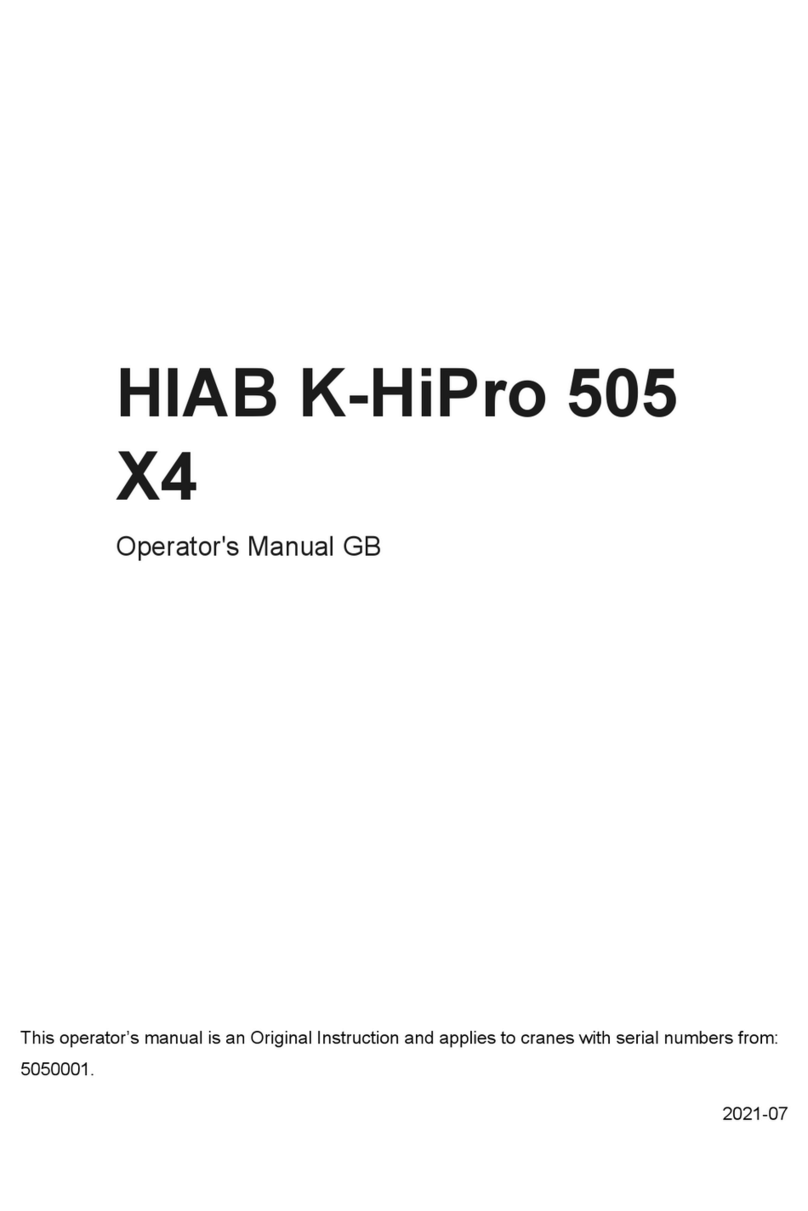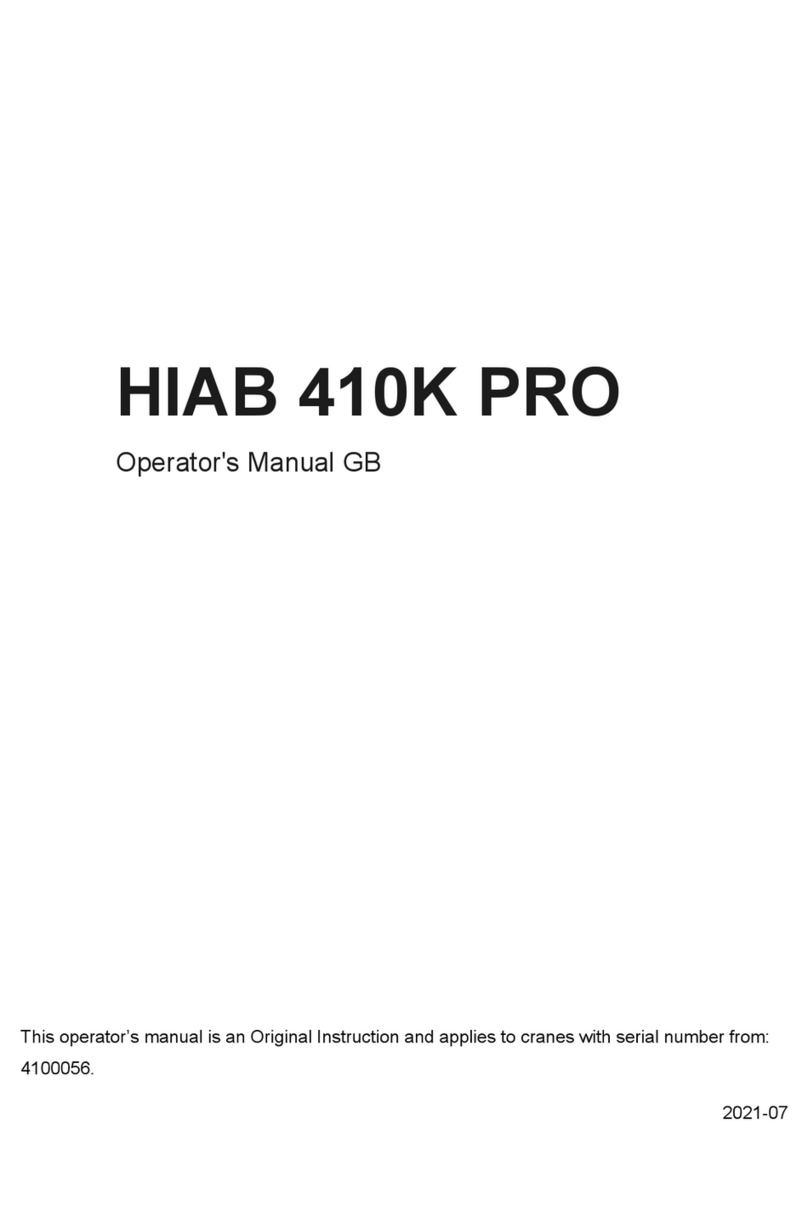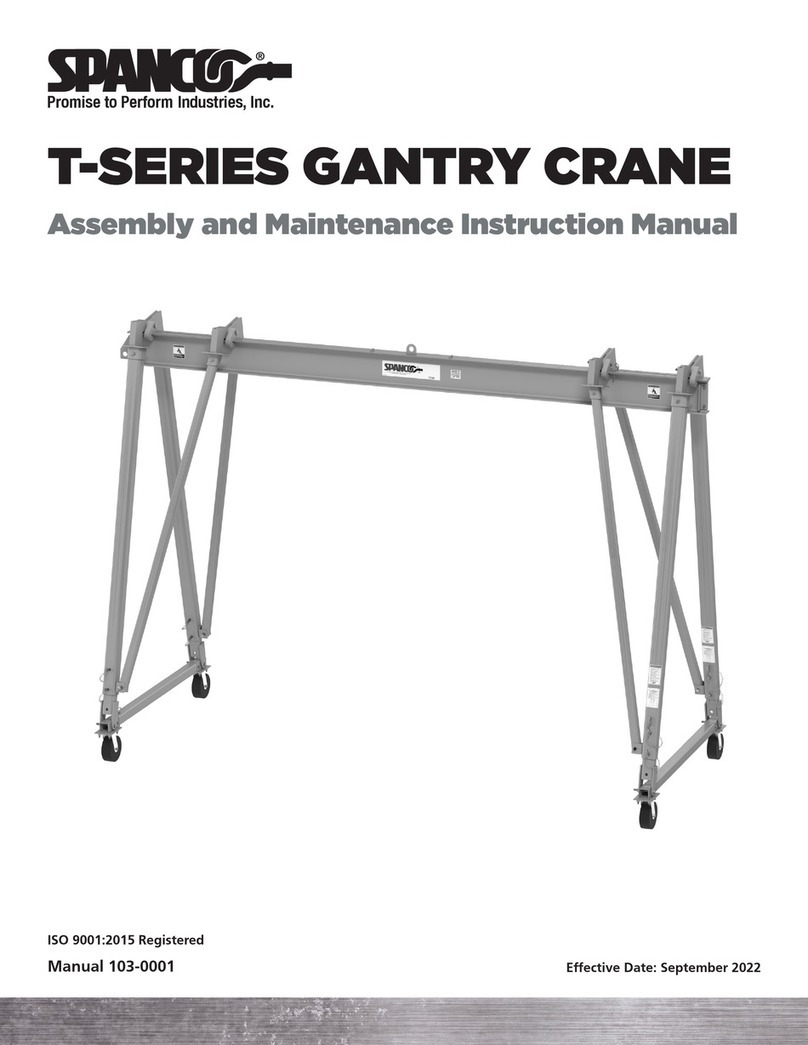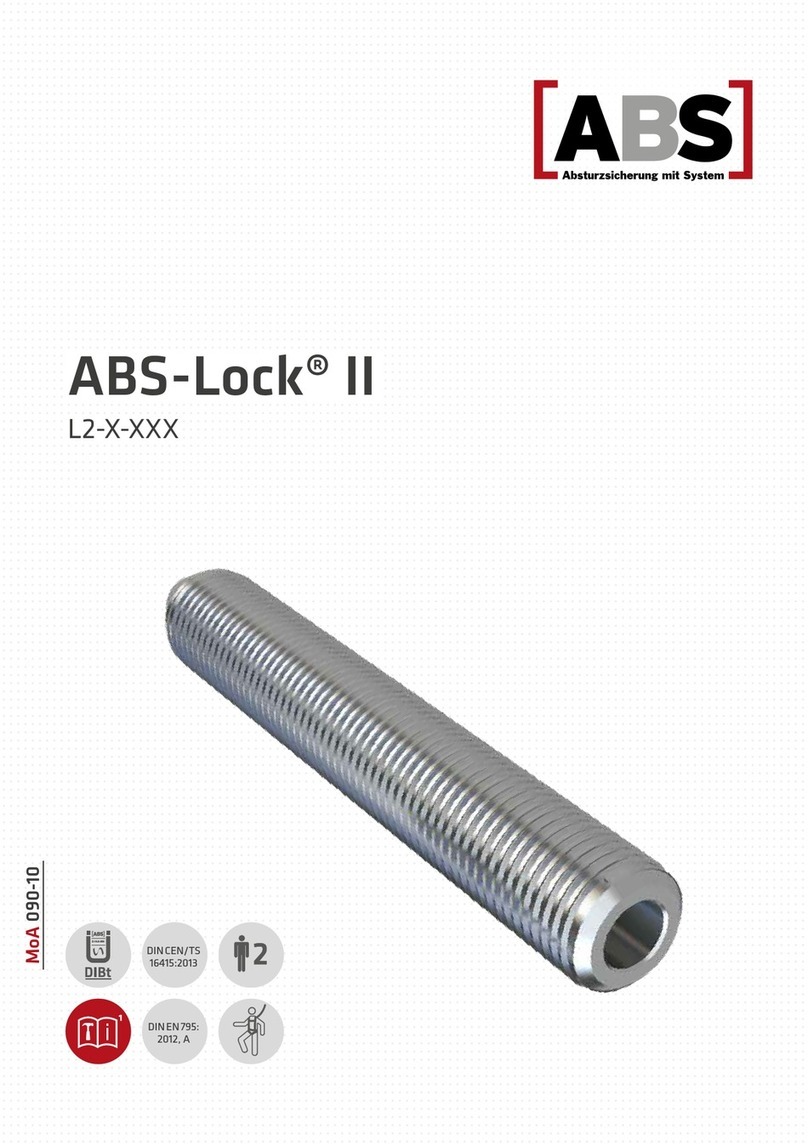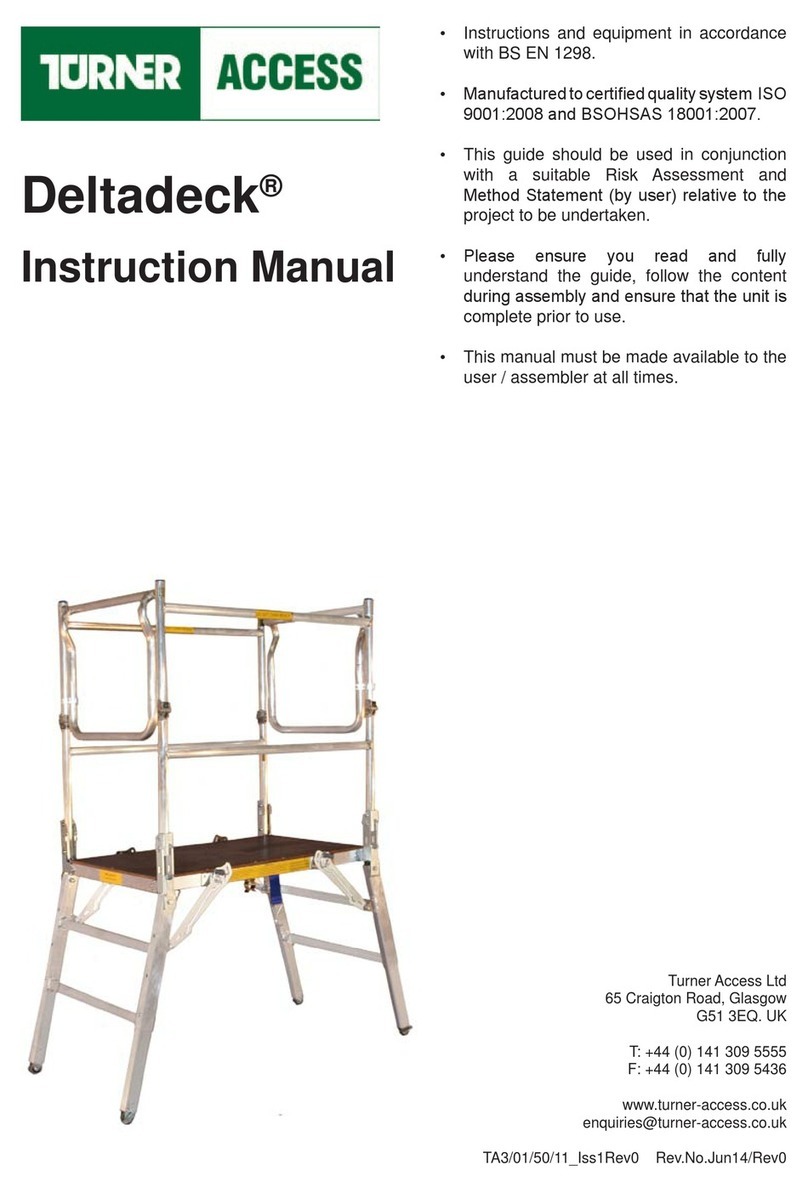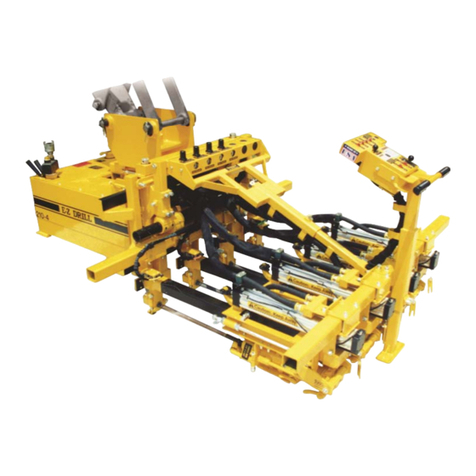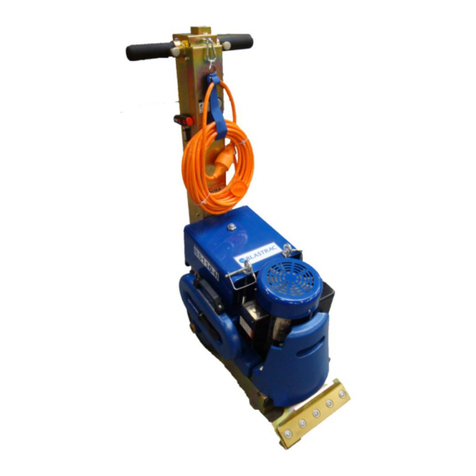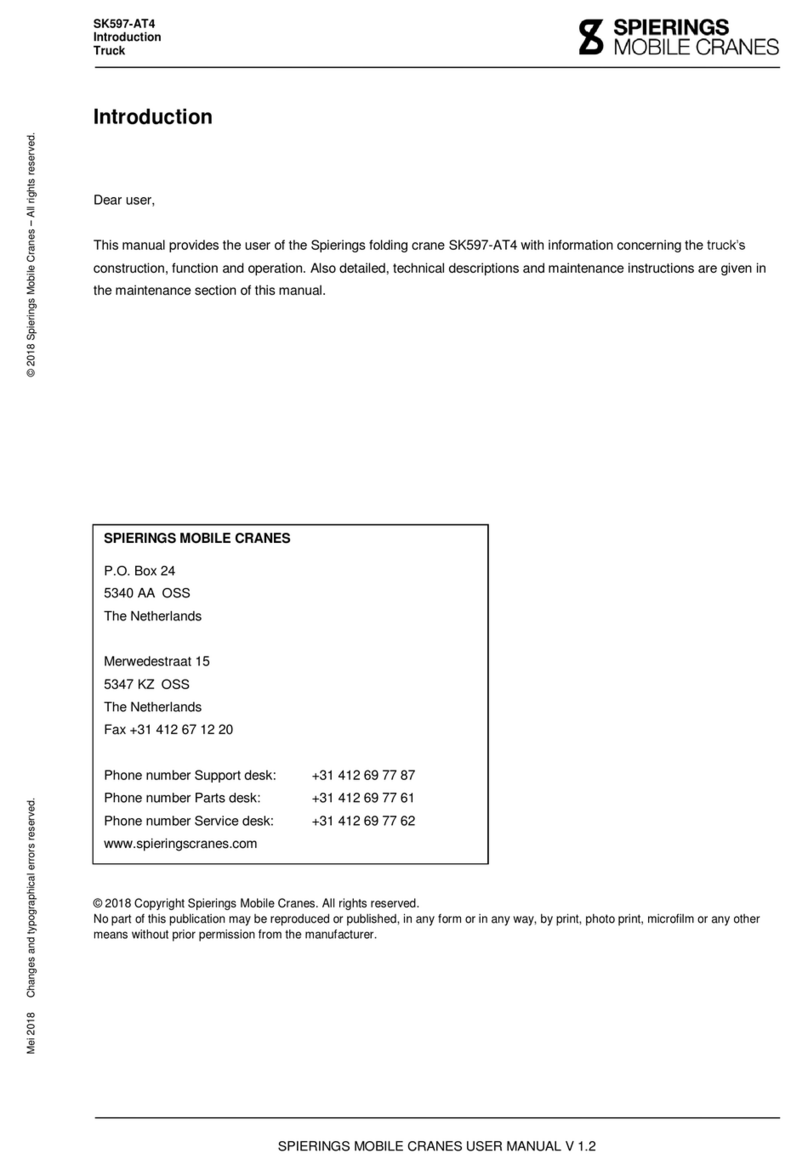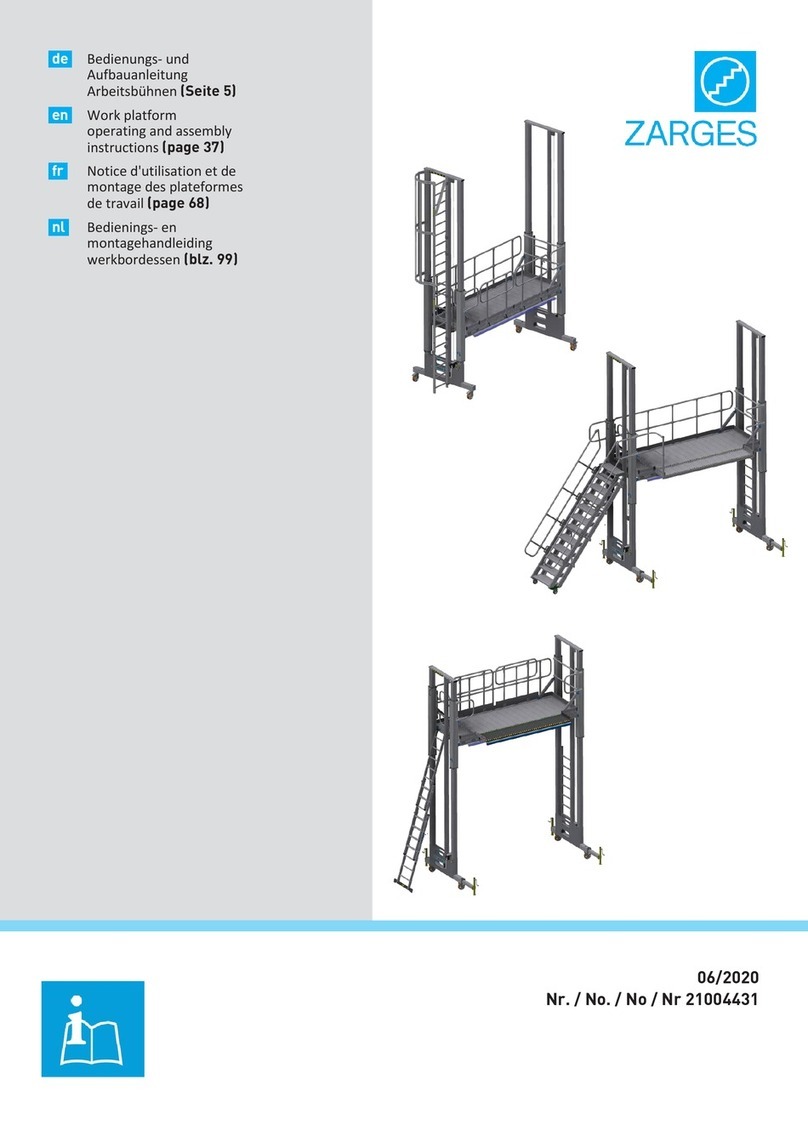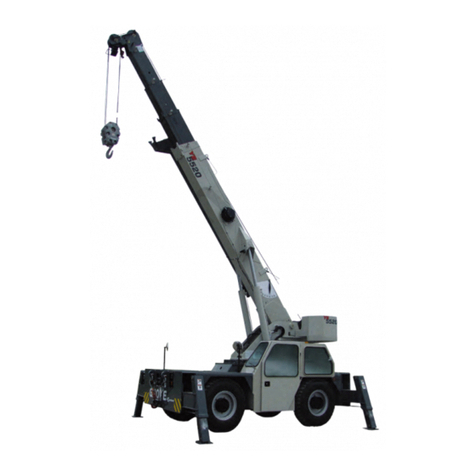HIAB HIAB T-HiDuo 013 CE User manual

This operator’s manual is an Original Instruction
and applies for cranes from serial number:
BL013000001, BL018000001, BL023000001, BL029000001, BL038000001
2016-04
Operator's Manual GB
HIAB T-HiDuo
013/018/023/029/038 CE

2Operator's Manual GB
Congratulations with your new crane!
You are now the owner of a quality product from
Cargotec, built to the highest standards of safety and
quality.
The aim of this manual is to help you handle your crane
safely and with full satisfaction.
Please read the complete manual. It provides detailed
information about the crane, control system and the
practical management and maintenance of the crane.
We advise you to read it carefully and familiarize yourself
with your crane before you start to use it.
Help us to improve this manual. Please send your

3
Table of Contents
Operator's Manual GB
1. Knowledge required............................................................................... 6
1.1 This Operator's Manual is intended for operators of this HIAB crane. .... 6
1.2 Indications in the Operator’s Manual ................................................ 7
1.3 The Machinery Directive 2006/42/EC ............................................. 10
1.3.1 Identification of the loader crane ............................................ 11
2. Structure and parts of the HIAB crane..................................................... 12
2.1 Main groups ............................................................................... 12
2.2 Crane base with column and slewing system .................................... 12
2.3 Boom system .............................................................................. 12
2.4 Boom system with hoist................................................................ 13
2.7 Stabiliser leg system..................................................................... 14
2.8 Operating system - hydraulic components ........................................ 15
2.9 LHV Load holding valves ............................................................. 15
2.10 Description of HIAB T-HiDuo 013/018/023/029/038 ......................... 16
3. Safety precautions and warnings............................................................. 17
3.1 Operating conditions .................................................................... 17
3.2 Definition of a HIAB loader crane.................................................. 18
3.2.1 Noise declaration................................................................. 19
3.2.2 Warning signs..................................................................... 20
3.2.3 Maximum load.................................................................... 20
3.2.4 Maximum load moment........................................................ 23
3.2.6 Determination - Hoist........................................................... 25
3.3 Signals when using a crane............................................................ 25
3.4 Wind speeds ............................................................................... 28
3.5 Use of the crane .......................................................................... 29
3.5.1 Preparations for use ............................................................. 31
3.5.4 Ending crane operation ......................................................... 35
3.6 Use of the Hoist .......................................................................... 36
3.7 Use of lifting equipment ............................................................... 38
3.8 Use of demountable cranes............................................................ 38
4. The Safety system................................................................................ 40
4.1 Safety System SPACE 4000 and Remote Control.............................. 40

4
Table of Contents
Operator's Manual GB
4.2 How the safety system works......................................................... 40
4.3 Components of the SPACE 4000 Safety System ............................... 41
4.4 Operating components .................................................................. 42
4.5 Main control valve....................................................................... 43
4.6 User panel SPACE 4000............................................................... 44
4.7 Indicator LEDs on user panel, SPACE 4000..................................... 45
4.8 XSDrive Lite controller ................................................................ 46
4.9 Indicator LED's on XSDrive Lite controller...................................... 48
4.10 Remote control XSDrive Lite with radio.......................................... 49
4.11 Battery charger XSDrive Lite ........................................................ 50
4.12 Menu selection XSDrive Lite......................................................... 50
4.13 Locking and unlocking the controller .............................................. 51
4.14 Functions in XSDrive Lite............................................................. 52
5. Starting crane operation ........................................................................ 54
5.1 Starting operations ....................................................................... 54
5.2 Extend stabiliser extensions and set stabiliser legs ............................. 56
5.3 Operate the crane out of parked position.......................................... 59
6. During operation ................................................................................. 60
6.1 OLP (Overload protection) ............................................................ 60
6.2 Manual extensions [option] ........................................................... 61
7. Change from hoist to hook operation ...................................................... 64
7.1 Change from hoist to hook operation .............................................. 64
8. Ending crane operation ......................................................................... 66
8.1 Operate the crane to parking position .............................................. 66
8.2 Placing the stabiliser legs in the transport position............................. 66
8.3 Switching off the safety system...................................................... 68
8.4 Emergency operation main control valve ......................................... 69
8.5 TWI Transport warning interface.................................................... 69
9. Maintenance and Service ...................................................................... 71
9.1 Service ...................................................................................... 71
9.2 Warranty.................................................................................... 72

5
Table of Contents
Operator's Manual GB
9.3 Follow the maintenance instructions! .............................................. 73
9.3.1 Daily inspection .................................................................. 75
9.3.2 Monthly inspection and maintenance....................................... 77
9.3.3 Annual maintenance............................................................. 79
9.3.4 Check rope ......................................................................... 80
9.3.5 Cleaning the rope ................................................................ 80
9.3.6 Requirements of the rope ...................................................... 81
9.3.7 Change of rope.................................................................... 82
9.4 Lubrication................................................................................. 84
9.4.1 Lubrication schedule ............................................................ 85
9.4.2 Lubrication of the column bearings......................................... 86
9.5 Hydraulics.................................................................................. 86
9.5.1 Replacing the cartridge in return oil filter ................................ 86
9.5.2 Checking the oil tank level.................................................... 87
9.5.3 Changing the hydraulic oil .................................................... 87
9.5.4 Hoist gear, top up or exchange oil .......................................... 90
9.5.5 Bleeding air from the hydraulic system.................................... 91
9.6 Troubleshooting .......................................................................... 93
9.6.1 Main fuses.......................................................................... 93
9.6.2 Faults on the crane............................................................... 94
9.6.3 Faults in the hoist ................................................................ 96
10. Decommissioning ................................................................................ 98
10.1 Decommissioning a crane.............................................................. 98
11. Technical Data .................................................................................. 100
11.1 Load plate table ......................................................................... 100

6
Knowledge required
Operator's Manual GB
1
1.1 This Operator's Manual is in-
tended for operators of this
HIAB crane.
This manual describes:
• Operation
• Safety precautions and warnings
• The crane control system
• Maintenance and troubleshooting
Enclosed to this manual the Installer will
provide:
• Technical Data for your crane
• Technical Data and manuals for add on
equipment if fitted
Study these instructions carefully
DANGER
If you do not study the complete Operator’s
Manual for your crane carefully, it could lead
to fatal accidents or serious damage.
Therefore you should:
• Study the entire Operator’s Manual carefully.
• Study the operating manuals for other add-on
equipment, if fitted.
• Use the crane only after having done so.
• Follow the directions for use, operation and
maintenance of the crane and add on equip-
ment exactly.
• Store the Technical Data and manuals from
the Installer, together with this Operator's
manual.
! NOTE
The manufacturer reserves the right to change
specifications, equipment, operating instructions
and maintenance instructions without prior notice.

7
Knowledge required
Operator's Manual GB
1.2
NOTE
HIAB shall at all times have the right to:
• install, maintain and dismantle automated re-
mote diagnostics system or similar sensor-
based system (the “System”) in and from the
Equipment; and
• access, send, receive, collect, store and use
any and all information and data gathered or
created by such System including but not
limited to information concerning operation,
operating environment, movement, condition,
logon, location and similar information relat-
ing to the Equipment (the “Information”).
The Customer shall not in any way remove or
alter the System, nor interfere with the use of the
System or the Information. The System and the
Information and all their further developments
shall at all times be and remain the exclusive
property of HIAB without granting any right or
license to the customer.
1.2 Indications in the Operator’s
Manual
What must you do and not do?
The following indications are used in the Opera-
tor’s Manual:
DANGER
Danger to life for yourself or to bystanders.
Follow the instructions carefully!
WARNING
Danger of injury to yourself or to bystanders,
or danger of serious damage to the crane or
other objects.
Follow the instructions carefully.

8
Knowledge required
Operator's Manual GB
1.2
CAUTION
Hazard for the crane or crane components.
Follow the instructions carefully.
Important:
If actions are numbered
1. Do this
2. Do that
3. ......
4. .....
5. .....
you should carry them out in numerical order!
! NOTE
Extra information that can prevent problems.
TIP
Tip to make the work easier to carry out.
Symbol for reference to a component in an
illustration
①Refers to a component in an illustration.
[option]: Indication for parts that are not-standard
for the crane, but are an option.
DANGER
Only persons with the requisite knowledge and
experience with cranes may use the crane.
Never operate the crane when you are sick,
tired, under the influence of medicines, alcohol
or other drugs.
• Take the delivery instructions from your
HIAB Service workshop, or receive instruc-
tion from an experienced person from your
own company. Only then should you operate
your crane.

9
Knowledge required
Operator's Manual GB
1.2
• Ensure that you comply with the statutory
requirements of the country in which you use
the crane (for example, certificate, obligatory
safety-helmet).
DANGER
• Carry out yourself only the service and
maintenance work you have the requisite
knowledge and experience of.
• All other maintenance work may only be
carried out by a HIAB service workshop.
• Ensure that every defect is rectified imme-
diately, according to the instructions.
• Follow the instructions exactly!
• All other work to rectify faults must be
performed by personnel in a HIAB service
workshop!
WARNING
• Never clean the electronic system, plastic
components, signs or bearings with a high-
pressure jet cleaner. It could cause damage.
• Never expose the electronic system to high
electrical voltages. This could damage the
safety system.
• Never immerse the controller in water or
other liquid. This will make the controller
unusable.
If your crane is equipped with add-on lifting
equipment:
• The operation of the crane with add-on
lifting equipment can differ from the oper-
ation as described in this manual.
• You should therefore study the Operating
Manual for the add-on equipment careful-
ly, before you use the crane.
• Take particular note whe placing the crane
in to or out of transport position.

Declaration of conformity with the
Machinery Directive 2006/42/EC
We ………………….
…………………
…………….
hereby declares that the loader crane:
Mark: …………..
Type:
Serial number:
……………..
.………………
Manufact. year: ………….
complies with the provisions of the machinery
directive 2006/42/EC;
also complies with the provisions of the
directive on electromagnetic compatibility
2004/108/EC as amended.
Technical file in accordance with Directive
2006/42/EC, Annex VII A is compiled by:
Name: …………………….
Address: ..............................
…………………….
This declaration is drawned up by:
Name …………………….
Position ……………………..
➀
➁
➂
➃
➄
xxxxxxxxxxx
xxxxxxxxxxx
10
Knowledge required
Operator's Manual GB
1.3
1.3 The Machinery Directive
2006/42/EC
• The Declaration of Conformity, delivered
with the crane contains ①:
• Business name and full address where the
crane is manufactured ②:
Factory addresses:
Hiab Cranes S.L.U. Pol. Ind. Malpica, calle
E, 86 50016 Zaragoza, Spain
Cargotec Poland Sp. z o. o. Ul. Metalowa 2,
73-102 Stargard, Poland
• Description and identification of the loader
crane ③:
Mark
Type: see chapter Identification of the crane.
Serial number
Manufact. year
Declaration of which provisions the loader
crane fulfils.
• Name and address of the person authorised to
compile the technical file ④:
Name
Address
• Identity and signature of the person who
drawn up the declaration ⑤:
Name
Position
Date and Signature

11
Knowledge required
Operator's Manual GB
1.3.1
1.3.1 Identification of the loader crane
The information below is to be filled in by the
installer. The same information will be found on
the serial number plate on the crane:
Mark: HIAB
Type: ..........................
Serial number: ............................
Manufact. year: ............................

12
Structure and parts of the HIAB crane
Operator's Manual GB
2
2.1 Main groups
The HIAB crane consists of the following main
groups:
• Crane base with column and slewing system
• Stabiliser system
• Boom system
• Operating system
2.2 Crane base with column and
slewing system
Crane base, column and the slewing:
• Crane base
worm wheel
hydraulic motor
• Column
bearings
• Cog wheel
2.3 Boom system
The boom system consists of the following
components:
• 1st boom ①
• Hydraulic extension ②
The length of the hydraulic extension depends
on the type of crane.
• Manual extension ③
Manual extension is slid by hand into the
hydraulic extension.

①
13
Structure and parts of the HIAB crane
Operator's Manual GB
2.4
2.4 Boom system with hoist
The boom system consists of the following
components:
•①1st boom
•②Hydraulic extensions
The length of the hydraulic extension depends
on the type of crane.
•③Hoist [option]
•④Sheave block [option]
The sheave block must only be attached to a
hydraulic extension. Never to a manual exten-
sion.
•⑤Counterweight [option]
•⑥Hook [option]

14
Structure and parts of the HIAB crane
Operator's Manual GB
2.7
Hoist [option]
The hoist consists of the following components:
①Rope
②Motor
③Electronic box
④Electrical wire to load sensor
⑤Pressure roller
⑥Wear plate for rope end monitoring
⑦Switch for 3-rolls left to rope end monitoring
Separate lifting accessories [option]
Separate lifting accessories, help to make or use a
slinging device: eye-hooks, shackles, eye-bolts
etc.
2.7 Stabiliser leg system
Every truck mounted HIAB crane has a minimum
of one stabiliser leg. Auxiliary stabilisers may be
needed for heavy cranes.
• Stabiliser beam ①
• Stabiliser extension ②.
• Stabiliser leg ③
• Stabiliser leg locking device ④
• Stabiliser extension locking device ⑤
• Support plate ⑥. The support plates are used
under the stabiliser legs for additional sup-
port.

15
Structure and parts of the HIAB crane
Operator's Manual GB
2.8
2.8 Operating system - hydraulic
components
The operating system consists of the following
hydraulic components:
• oil tank
• hydraulic pump
PTO or a 12V/24V motor
• Main control valve
• hydraulic hoses and pipes
• actuators:
first boom cylinder
extension cylinder/s
• filter/s
2.9 LHV Load holding valves
The cylinder is equipped with a load-holding
valve. After a crane movement it holds the crane
in position.
If there is a leak or a component fractures, such
as a pipe, hose or a coupling, the load-holding
valve will stop the boom from collapsing down,
even when the hydraulic system is switched off,
and you operate a particular crane function.
To operate a hydraulic cylinder equipped with a
load holding valve, an opening pressure is re-
quired.

16
Structure and parts of the HIAB crane
Operator's Manual GB
2.10
2.10 Description of HIAB T-HiDuo
013/018/023/029/038
The HIAB T-HiDuo 013/018/023/029/038 are
compact, hydraulically operated goods cranes and
fulfil the European Machinery Directive require-
ments specified in the standard EN12999. The
cranes are stress class S0, according to EN13001.
Lifting capacity:
• HIAB T-HiDuo 013 = approx. 1,2 tonne
metres
• HIAB T-HiDuo 018 = approx. 1,8 tonne
metres
• HIAB T-HiDuo 023 = approx. 2,3 tonne
metres
• HIAB T-HiDuo 029 = approx. 2,8 tonne
metres
• HIAB T-HiDuo 038 = approx. 3,6 tonne
metres
The cranes are supplied in versions from:
HIAB T-HiDuo 013-1 (reach 2 metres) to HIAB
T-HiDuo 013-3 (reach 4,2 metres)
Note! VSL is not available on Hiab T-HiDuo 013
HIAB T-HiDuo 018-1 (reach 2 metres) to HIAB
T-HiDuo 018-3 (reach 4,2 metres)
HIAB T-HiDuo 023-2 (reach 3,4 metres) to
HIAB T-HiDuo 023-3 (reach 4,4 metres)
HIAB T-HiDuo 029-2 (reach 3,4 metres) to
HIAB T-HiDuo 029-4 (reach 5,5 metres)
HIAB T-HiDuo 038-2 (reach 3,6 metres) to
HIAB T-HiDuo 038-4 (reach 6 metres)
The crane type and the manufacturer are marked
on the serial number plate.
! NOTE
The exact technical information for your crane is
shown in the Technical Data.

17
Safety precautions and warnings
Operator's Manual GB
3
3.1 Operating conditions
You may only use the crane under the following
conditions:
• In the open air, or in spaces with sufficient
ventilation.
DANGER
• If you use the crane in a confined space
you could suffocate from the exhaust gases
from the vehicle.
• With a mean wind velocity less then 13.3
m/sec (approx. 29.7 mph). See the wind
speed table.
• Never use the crane in a high wind or
storm. When the mean wind velocity ex-
ceeds 13.3 m/sec (approx. 29.7 mph) the
crane will behave unpredictably. Never use
the crane during a thunderstorm.
•Never use the crane at temperatures below
-40° C (-40 °F), as the steel's properties
deteriorate below this temperature.
WARNING
• At temperatures below 0 °C (32 °F):
Do not touch the operating levers during
the first few minutes.
• When starting in cold weather, the wear on
the hydraulic system is greater than at
normal working temperatures.
To minimise wear, the crane should be started as
follows:
• Engage the power take-off at low rpm.
• Allow the system to idle for a few minutes.
• Operate the stabiliser leg up for one minute in
order to warm up the oil.
• Working with hoist in temperatures below -10
°C (14 °F) operate the hoist in both directions
without load for a few minutes to warm up
the oil.

18
Safety precautions and warnings
Operator's Manual GB
3.2
3.2 Definition of a HIAB loader
crane
Usage of the crane
The HIAB loader crane is used to lift and move
loads in the working area permitted by the load
plate and the load diagram. The cranes are
normally mounted on a vehicle but they can also
be mounted on a fixed base plate. The crane can
be equipped with a number of accessories.
Loader cranes are designed for loading and
unloading the vehicle, as well as for other duties
as specified:
Permitted duties:
• Loading and unloading cargo from/to a vehi-
cle
• Lifting of loads from the ground/vehicle to a
higher place
• Installation work (beams, concrete plates,
windows...) in building constructions
• Lifting construction material (wall boards,
bricks, blocks…) on a pallet fork to a build-
ing, taking the material from the vehicle on
which the crane is mounted, from another
vehicle or from the ground
• Hoisting, e.g. beams, concrete plates and any
other material and equipment used in building
construction
• Collection of waste and recycling material
(glass, paper, cardboard, plastic…)
• Installation of informative posts, road signs,
notice boards, traffic lights, street lights…
• Handling submerged pumps in wells, using a
hoist
Forbidden duties:
• Crane mounted onboard ships or floating
structures, only permitted in cases authorized
by HIAB

19
Safety precautions and warnings
Operator's Manual GB
3.2.1
• Continuous use as a production crane in
assembly lines, foundries…, except for cranes
prepared for that purpose
• Loading cargo that is partially loaded or
fastened by other means, without making sure
the capacity of the crane is enough for the
entire load
• Any duty which implies:
• Pressure against the ground, unless the
crane is specifically prepared for this
• Push/pull with the boom system against
any type of obstacle (wall, ground…)
3.2.1 Noise declaration
The following values for emitted noise may be
taken as general and conservative values for
ordinary installations of loader cranes on normal
diesel engine powered trucks. Declared dual-
number noise emission values in accordance with
ISO 4871:
• Emitted A-weighted sound power level for
basic loader cranes in accordance with ISO
3744: LwA = 103 dB (Uncertainty: KwA = 2
dB).
• Emitted A-weighted sound power level for
loader cranes with hoist in accordance with
ISO 3744: LwA = 107 dB (Uncertainty: KwA
= 2 dB).
• A-weighted sound pressure level at loader
crane control stations in accordance with ISO
11201: LpA = 95 dB (Uncertainty: KpA = 4
dB).
Particular installations can be quieter, in which
case a post installation noise measurement in
accordance with clause 6.3 of EN 12999:2011
may be used to prove this.

LOADER CRANE
METALOWA2, 73-102 STARGARDSZCZECINSKI
CARGOTECPOLAND SP. Z 0.0.
POLAND
187-5931/2
x.x x.x x.x x.x
x.x
xxxx xxxx xxx xxx
xxx
kg
xxxxxxx
kg
3874744
8 m
7
6
5
4
3
2
1
0
-1
-2
-3
-4
0 1 2 3 4 5 6 m
1820 1065 725 550 430
20
Safety precautions and warnings
Operator's Manual GB
3.2.2
3.2.2 Warning signs
3.2.3 Maximum load
Lifting capacity
Your crane has a certain lifting capacity, ex-
pressed in kNm or tm. This lifting capacity is
also known as the load moment. The lifting
capacity is: the payload at hook multiplied by the
outreach in metres that the crane can operate at
different positions. The lifting capacity of your
crane determines the maximum load your crane
may lift within its working zone. However take
careful note; the greater the operating radius of
the crane, the lower the lifting capacity will be
because of the weight of the boom system itself.
The load plate and the load diagram on your
crane show the maximum loads you may lift in
the operating reach of your crane.
This manual suits for next models
4
Table of contents
Other HIAB Construction Equipment manuals
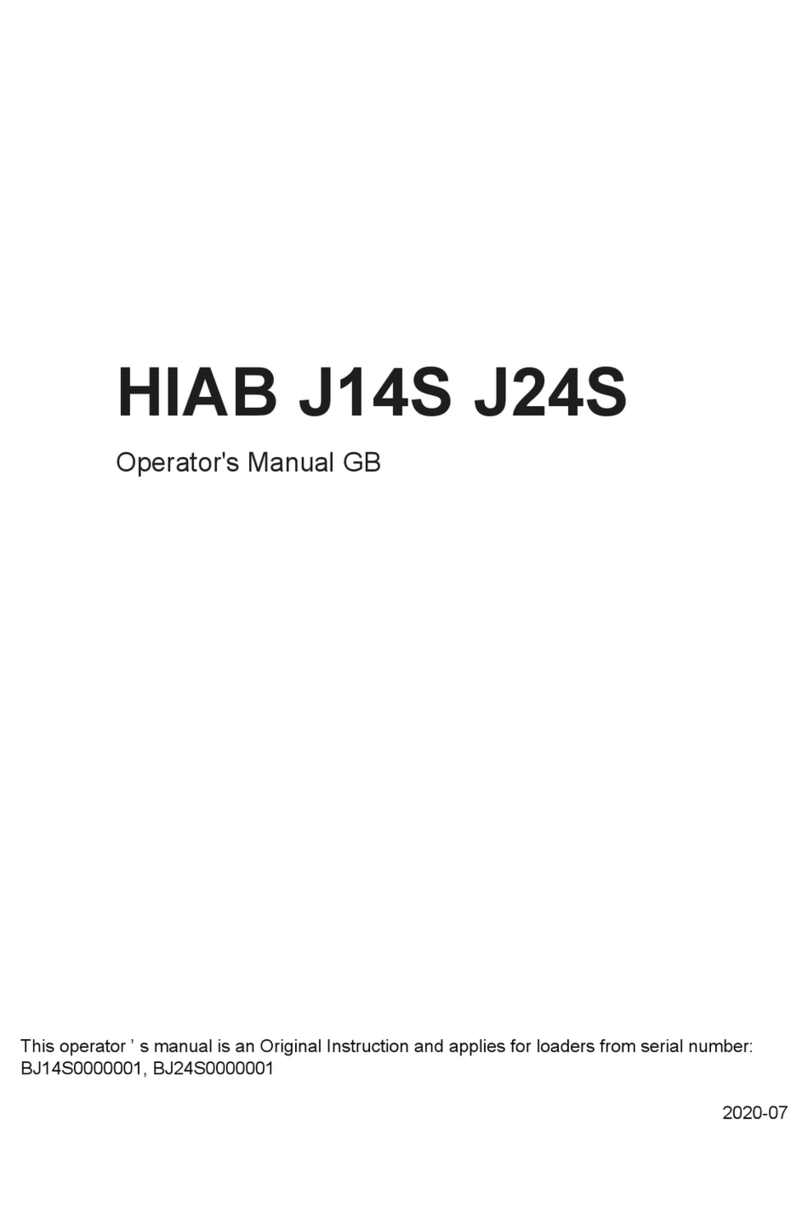
HIAB
HIAB J14S User manual
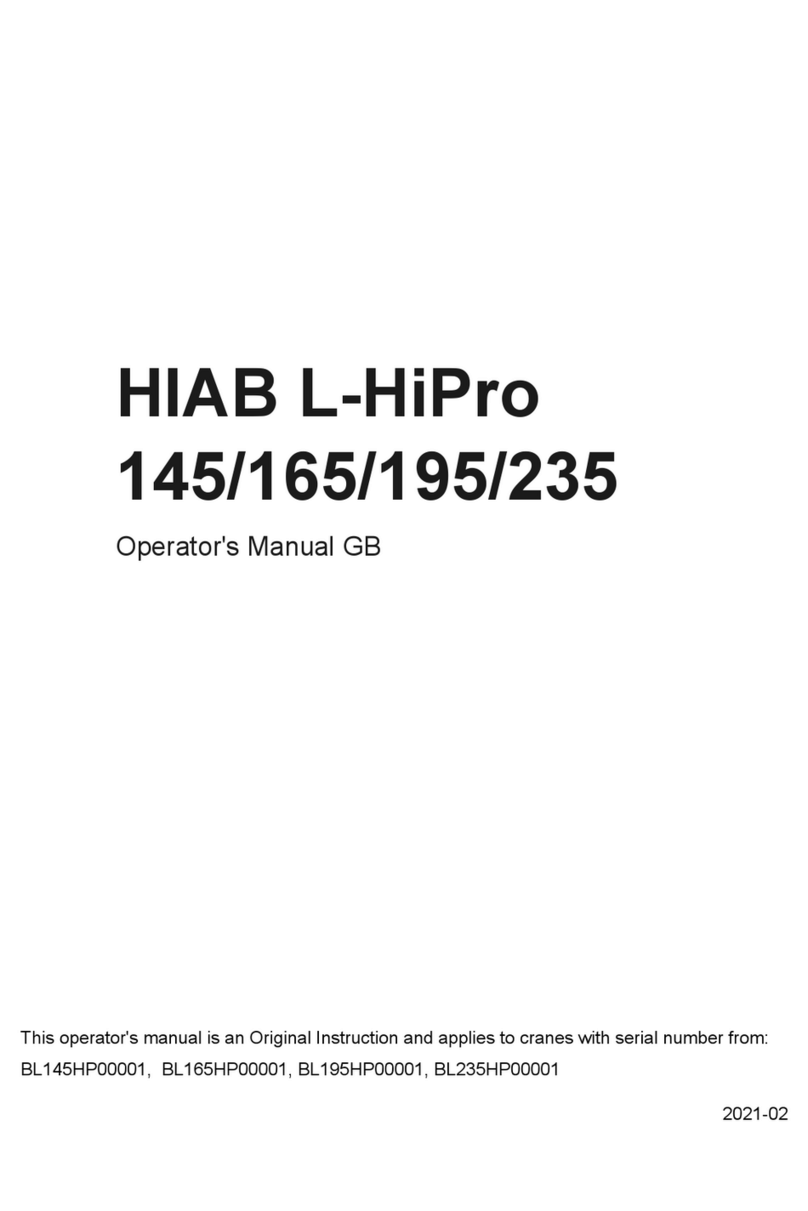
HIAB
HIAB L-HiPro 145 User manual
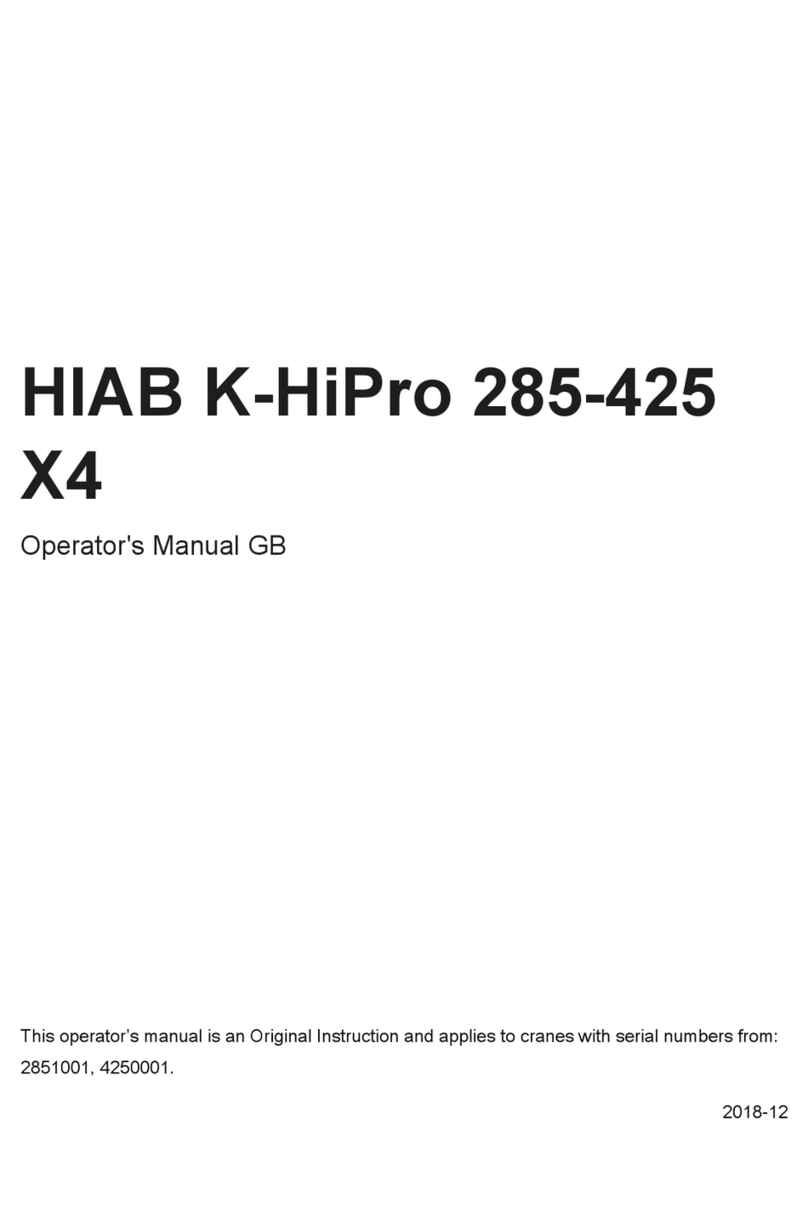
HIAB
HIAB K-HiPro 285-425-4 Series User manual
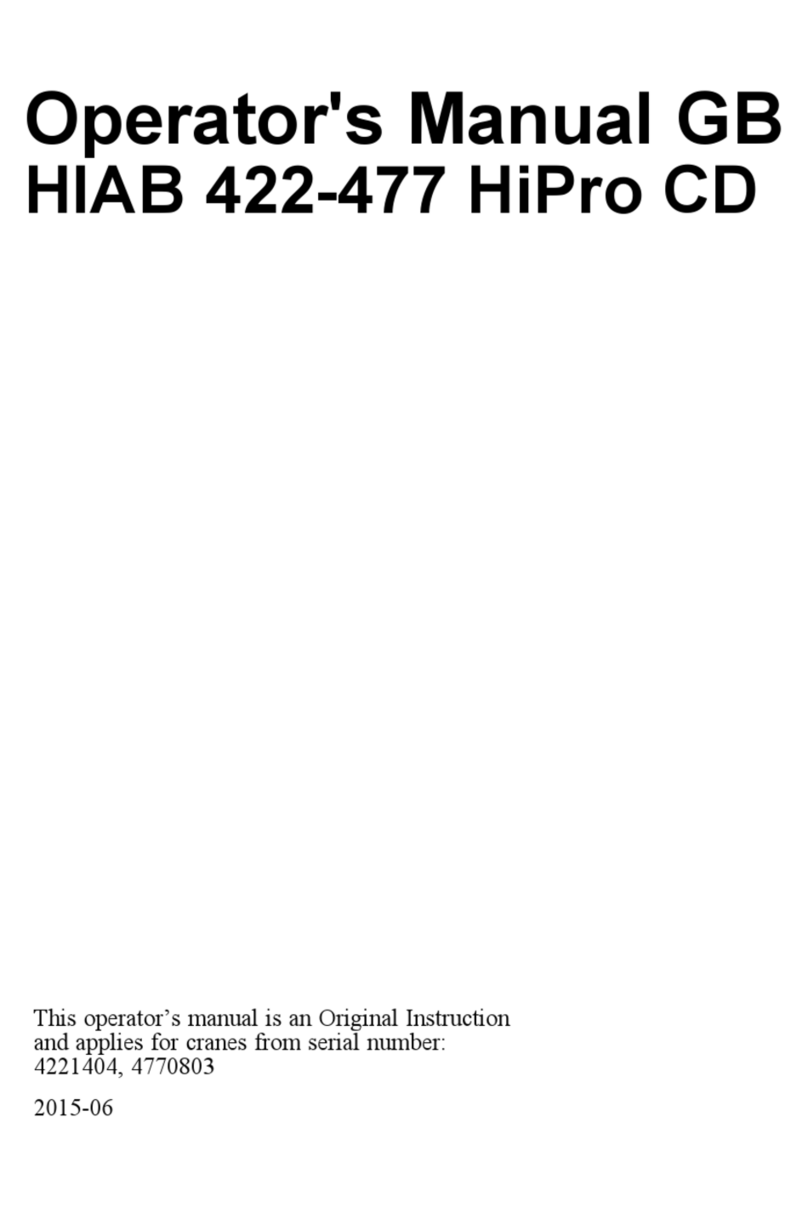
HIAB
HIAB 422-477 HiPro CD User manual

HIAB
HIAB X-HiPro 358-408-418 X4 User manual
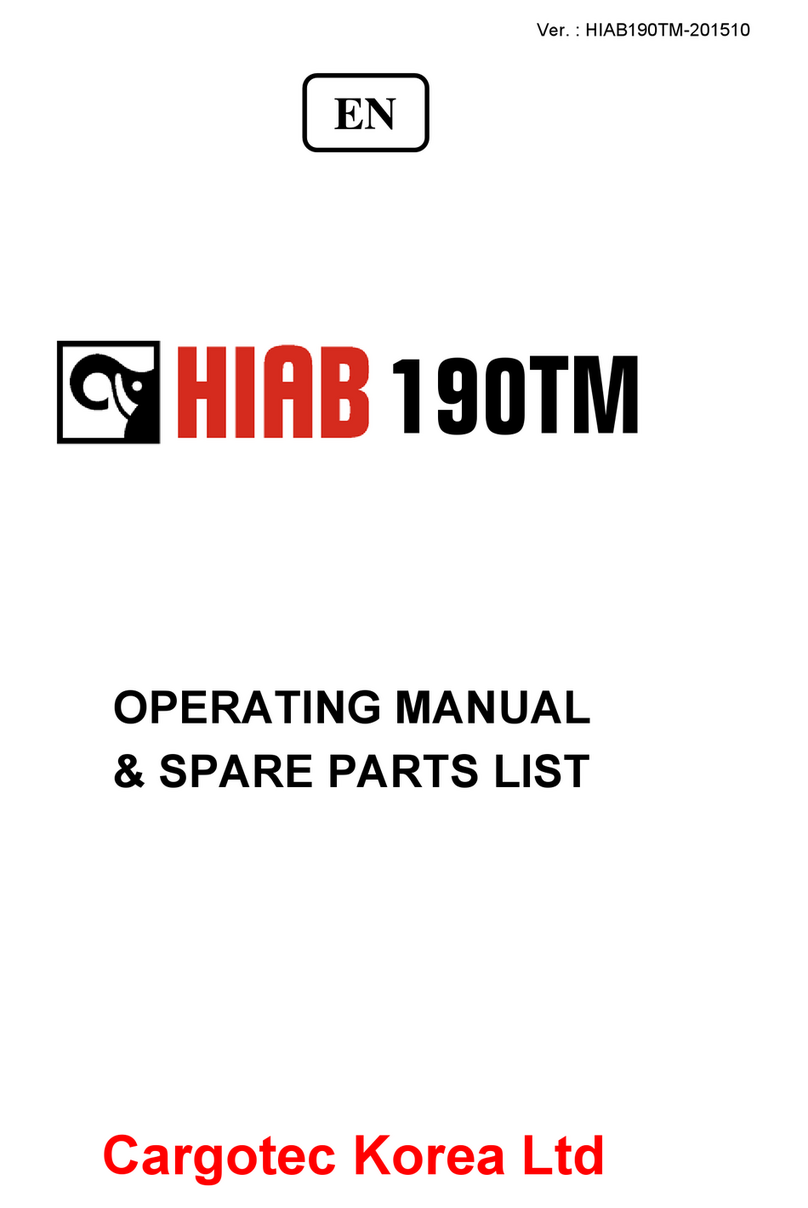
HIAB
HIAB 190TM Guide

HIAB
HIAB 335K HiPro CD CE User manual
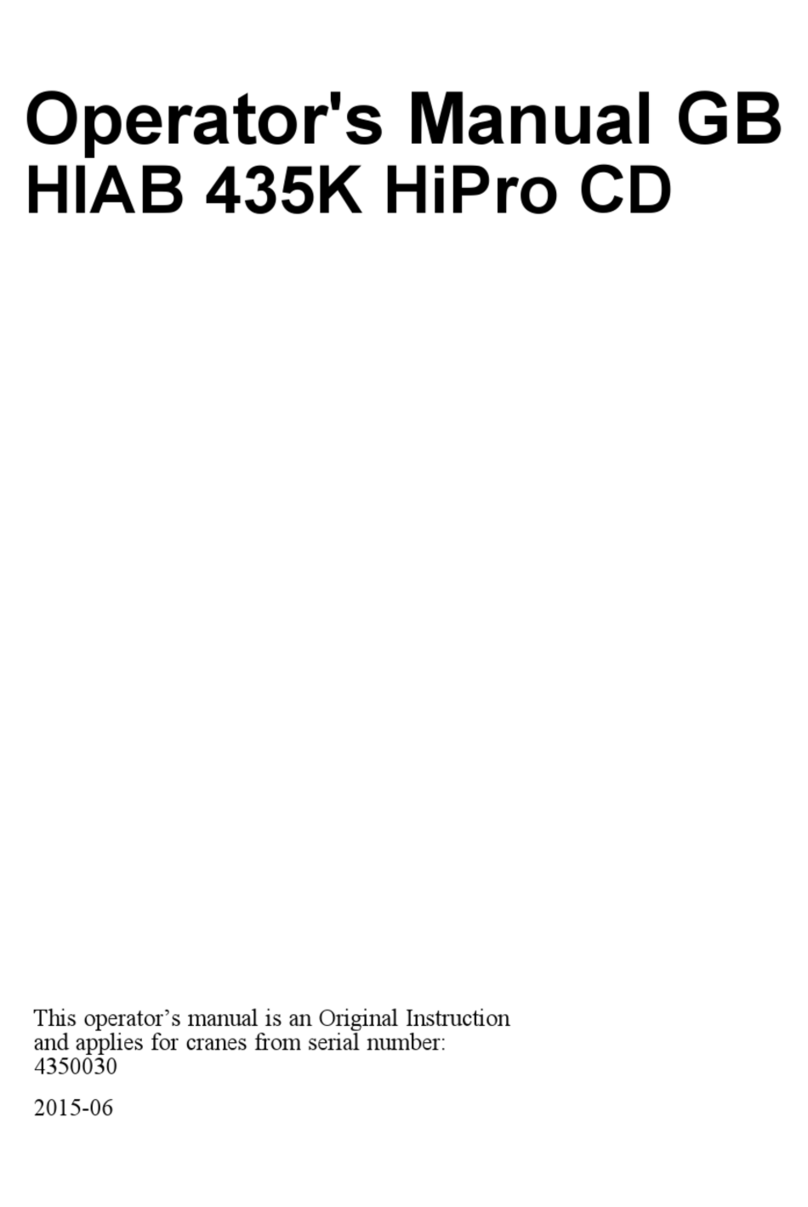
HIAB
HIAB 435K HiPro CD User manual
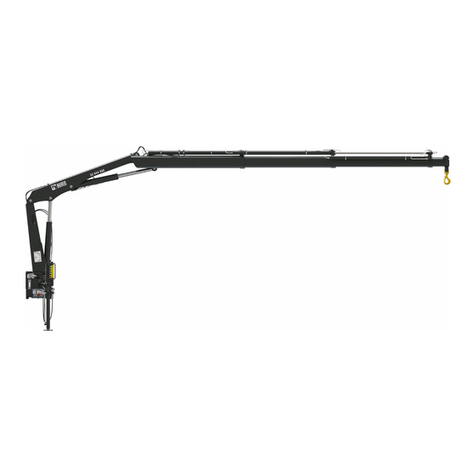
HIAB
HIAB X-Duo 044 User manual
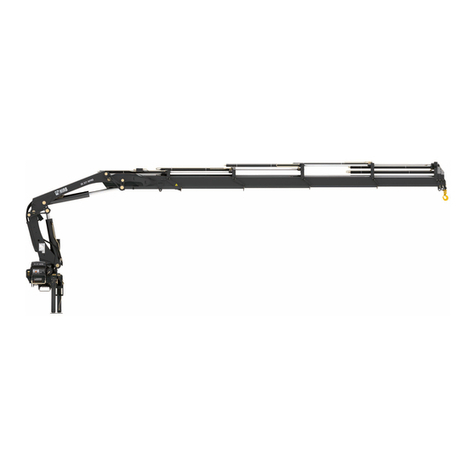
HIAB
HIAB 322 HiPro CD User manual
Popular Construction Equipment manuals by other brands
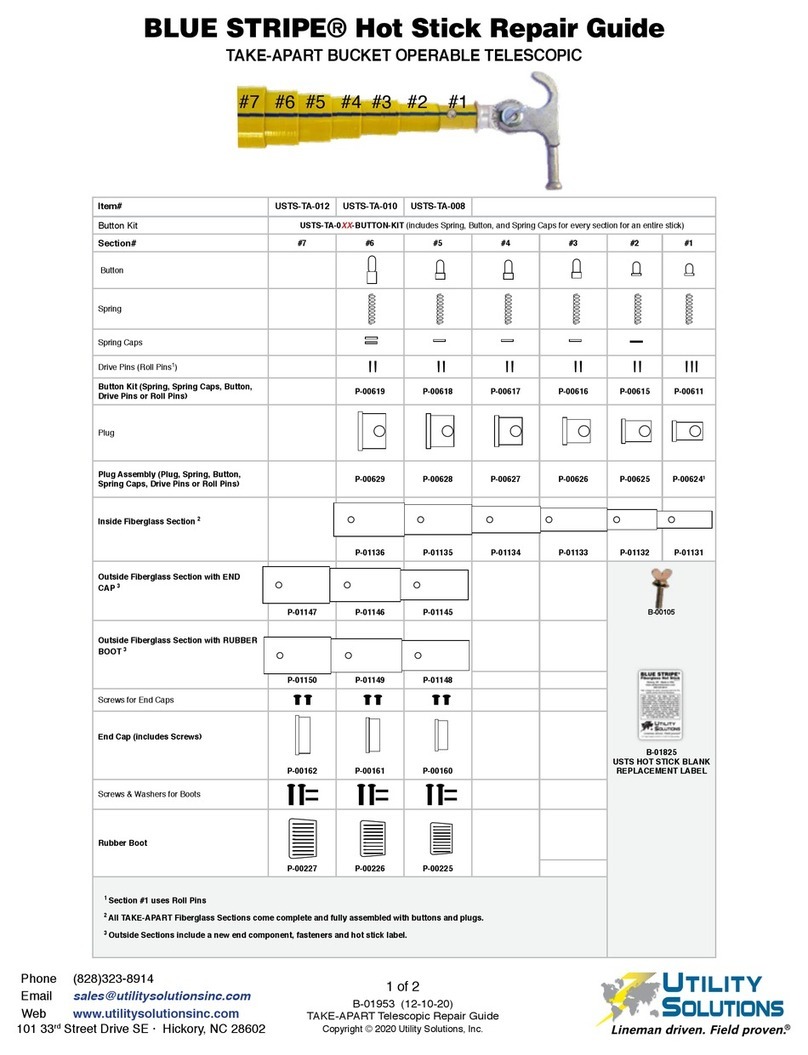
Utility Solutions
Utility Solutions BLUE STRIPE Hot Stick Repair guide

SANY
SANY STG210C-8 Safety, Operation & Maintenance Manual/Parts List

Jet
Jet JHC-200X Operating instructions and parts manual
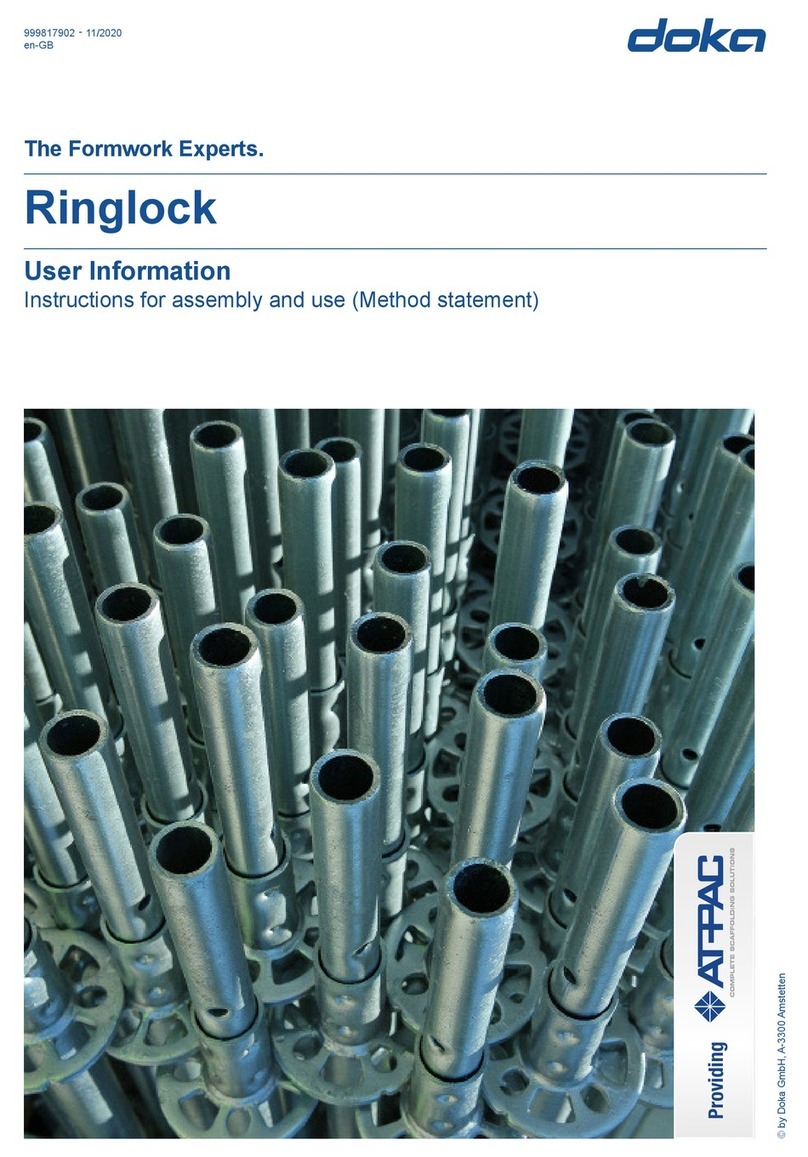
Doka
Doka Ringlock User information
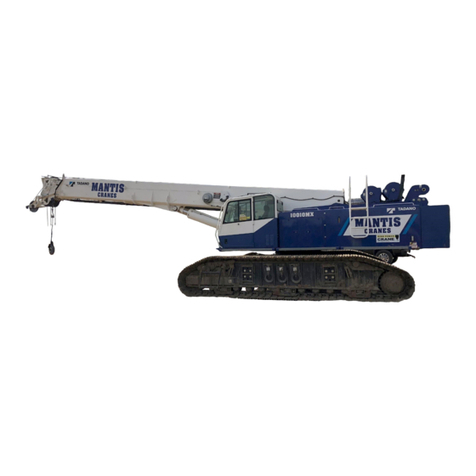
Tadano
Tadano Mantis 10010MX Operating and maintenance manual

Dynapac
Dynapac CS 141 maintenance

